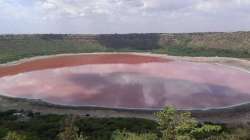Lonar Lake turns pink: Why the mysterious colour change
Maharashtra's Lonar Lake, the world's third largest crater, has adopted a pinkish hue, leaving experts baffled over the mysterious colour change. Typically, the colour of the lake appears to be like emerald green. The authorities are digging in to find out the real reason behind the colour change. Meanwhile, various theories and claims are afloat.

Maharashtra's Lonar Lake, the world's third largest crater, has adopted a pinkish hue, leaving experts baffled over the mysterious colour change. Typically, the colour of the lake appears to be like emerald green. The authorities are digging in to find out the real reason behind the colour change. Meanwhile, various theories and claims are afloat.
Gajanan Kharat, member of the Lonar Lake conservation and development committee, told PTI that salinity and algae can be responsible for this colour change of Lonar Lake.
According to Gajanan, there is no oxygen below one meter of Lonar Lake's water surface. There is an example of a lake in Iran where water becomes reddish due to an increase in salinity.
He also said that the level of water in the Lonar Lake is currently low as compared to the past few years and there is no rain to pour fresh water in it.
"The low level of water may lead to increased salinity and change in the behaviour of algae because of atmospheric changes...this may be the reason for colour change. This is not the first time that the colour of water has changed," he told PTI.
Meanwhile, another expert ruled out any human intervention. Madan Suryavanshi, head of the geography department of Aurangabad's Dr. Babasaheb Ambedkar Marathwada University, said looking at the scale of this colour change, this can't be "human intervention."
"In case of a natural phenomenon, there are fungi which generally give a greenish colour to water most of the times. This seems to be a biological change in the Lonar crater," he said.
During the lockdown phase, there may not have been any disturbance to water which led to this change, he said.
"Season-wise changes occur in water and this might be the case with the Lonar lake. We can examine the change if we go there in a week...then we can say more about the change," he said.
(With PTI inputs)
